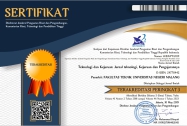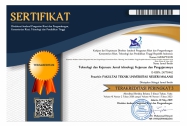Industrial Class Model during the Pandemic to Support Link and Match Industries and Vocational High Schools
Abstract
The industrial class was formed to provide a knowledge and broader insight to students based on the development of competencies required by industries. However, several Vocational High Schools (VHS) unused industrial classes during the pandemic because the school partner industries is being impacted by the Covid-19 pandemic. The study was conducted to determine the implementation of industrial class model used during the pandemic. The research method uses quasi-qualitative. The research was conducted at Telkom Malang Vocational High School on software engineering skills competency. The finding showed collaboration form in the industrial class between industriesand VHS are curriculum synchronization, student selection, teacher training, implementation of street vendors and job recruitment. The implementation of industrial class is done online by monitoring students by school and industry supervisors. Industrial class students have a group project task formed. Supporting and inhibiting factors in the sustainability of the industrial class during the pandemic. Supporting factors are selected students with high abilities by selection process, and industrial partner support for industrial class implementation. While the inhibiting factor is online learning process, it cannot help the teacher to monitor student activities and build students mental directly.
The industrial class was formed to provide a knowledge and broader insight to students based on the development of competencies required by industries. However, several Vocational High Schools (VHS) unused industrial classes during the pandemic because the school partner industries is being impacted by the Covid-19 pandemic. The study was conducted to determine the implementation of industrial class model used during the pandemic. The research method uses quasi-qualitative. The research was conducted at Telkom Malang Vocational High School on software engineering skills competency. The finding showed collaboration form in the industrial class between industriesand VHS are curriculum synchronization, student selection, teacher training, implementation of street vendors and job recruitment. The implementation of industrial class is done online by monitoring students by school and industry supervisors. Industrial class students have a group project task formed. Supporting and inhibiting factors in the sustainability of the industrial class during the pandemic. Supporting factors are selected students with high abilities by selection process, and industrial partner support for industrial class implementation. While the inhibiting factor is online learning process, it cannot help the teacher to monitor student activities and build students mental directly.
Keywords
Full Text:
PDFReferences
Achsani, H., Kustono, D., & Suhartadi, S. (2020). Model Kelas Industri pada Mitsubishi School Program di Sekolah Menengah Kejuruan. Jurnal Pendidikan: Teori, Dan Pengembangan, 5(8), 1078–1085. http://journal.um.ac.id/index.php/jptpp/article/view/13878
Anisah, N., Triana, D. D., & Sutisna, A. (2020). Link And match pendidikan sistem ganda dalam program praktek kerja industri smk islam terpadu. Prosiding Seminar Nasional Pascasarjana Universitas Negeri Jakarta, 1(1), 354–359. http://journal.unj.ac.id/unj/index.php/semnas-ps/article/view/16911/9183
Arfandi, A., & Sampebua, O. (2016). Kesiapan Pelaksanaan Praktik Kerja Industri Program Studi Keahlian Teknik Bangunan Di Kota Makassar. Jurnal Cakrawala Pendidikan, 1(1), 80–87. Doi: https://doi.org/10.21831/cp.v1i1.8377
Azman, A., Simatupang, W., Karudin, A., & Dakhi, O. (2020). Link and Match Policy in Vocational Education To Address the Problem of Unemployment. International Journal of Multi Science, 1(6), 76–85. https://multisciencejournal.com/index.php/ijm/article/download/78/60
Cahyanti, S. D., Indriayu, M., & Sudarmo. (2018). Implementasi Program Link and Match dengan Dunia Usaha dan Dunia Industri pada Lulusan Pemasaran SMK Negeri 1 Surakarta. BISE: Jurnal Pendidikan Bisnis Dan Ekonomo, 4(1), 1–22. https://jurnal.fkip.uns.ac.id/index.php/ptn/article/view/12143
Disas, E. P. (2018). Link and Match sebagai Kebijakan Pendidikan Kejuruan. Jurnal Penelitian Pendidikan, 18(2), 231–242. Doi: https://doi.org/10.17509/jpp.v18i2.12965
Hadam, S., Rahayu, N., & Ariyadi, A. N. (2017). Strategi Implementasi Revitalisai SMK (10 Langkah Revitalisasi SMK). Jakarta: Direktorat Pembinaan Sekolah Menengah, Direktorat Jenderal Pendidikan Dasar dan Menengah, Kementerian Pendidikan dan Kebudayaan. http://repositori.kemdikbud.go.id/5263/1/riXIT33kky7AMpjt8Qcz96oWg1ef5ixukA8vozns.pdf
Hartog, J., Raposo, P., & Reis, H. (2021). Fluctuations in The Wage Gap Between Vocational and General Secondary Education: Lessons from Portugal. Journal of Population Economics, 1–33. Doi: https://doi.org/10.1007/s00148-021-00846-1
Husein, M. T. (2019). Link and Match Pendidikan Sekolah Kejuruan. Jurnal Pemikiran Dan Pencerahan, 15(2), 39–62. Doi: https://doi.org/10.31000/rf.v15i2.2037
Indana, L., & Soenarto. (2019). Vocational Career Center as the Bridge between Industry and Vocational High School Graduates. Jurnal Pendidikan Teknologi Dan Kejuruan, 25(2), 219–228. Doi: https://doi.org/10.21831/jptk.v25i2.19817
Indaryatno, A., Trisnamansyah, S., & Muctar, S. H. (2020). Manajemen Revitalisasi Sekolah Menengah Kejuruan dalam Upaya Meningkatkan Mutu Lulusan (Studi Kasus Penerapan Revitalisasi SMK Negeri 3 dan SMK Negeri 13 Bandung. Nusantara Education Review, 3(April), 1–11.
Irwanto. (2021). Link and Match Pendidikan Kejuruan dengan Dunia Usaha dan Industri di Indonesia. Jurnal Inovasi Penelitian, 2(2), 549–562. https://stp-mataram.e-journal.id/JIP/article/view/714
Johan, A. B., PH, S., & Widodo. (2019). Evaluation of Education Implementation of Link and Match Systems of the Industrial and Vocational School in Yogyakarta Province. Jurnal Taman Vokasi, 7(2), 216–222. https://jurnal.ustjogja.ac.id/index.php/tamanvokasi/article/view/7070
Kai, S. Y. S. (2020). Evaluation of Industrial Work Practice (Prakerin). Management Research, 3(1), 132–145. Doi: https://doi.org/https://doi.org/10.32662/gomares.v3i1.1008
Kemdikbud. (2021). Panduan Pembelajaran Jarak Jauh. Kementrian Pendidikan Dan Kebudayaan, 021, 28. https://bersamahadapikorona.kemdikbud.go.id/panduan-pembelajaran-jarak-jauh/
Löfgren, S., Ilomäki, L., & Toom, A. (2020). Employer Views on Upper-Secondary Vocational Graduate Competences. In Journal of Vocational Education and Training (Vol. 72, Issue 3). Doi: https://doi.org/10.1080/13636820.2019.1635633
Manalu, S. R. I. (2019). Developing the Teaching Factory Learning Model to Prepare the Students of Vocational High School in Facing Global Competitions. 299(Ictvet 2018), 130–134. Doi: https://doi.org/10.2991/ictvet-18.2019.28
Melasi, M. N. (2018). Pengelolaan Pendidikan Karakter Pada Kegiatan Prakrik Kerja Industri di SMK. Jurnal Managemen Pendidikan, 13(1), 34–43. Doi: https://doi.org/https://doi.org/10.23917/jmp.v13i2.6394
Mukhadis, A., Rahma Putra, A. B. N., Nidhom, A. M., Dardiri, A., & Suswanto, H. (2018). The Relevance of Vocational High School Program with Regional Potency Priority in Indonesia. Journal of Physics: Conference Series, 1028(1), 1–8. Doi: https://doi.org/10.1088/1742-6596/1028/1/012079
Munthe, A. P. (2015). Pentingya Evaluasi Program Di Institusi Pendidikan: Sebuah Pengantar, Pengertian, Tujuan dan Manfaat. Scholaria : Jurnal Pendidikan Dan Kebudayaan, 5(2), 1–14. Doi: https://doi.org/10.24246/j.scholaria.2015.v5.i2.p1-14
Muryadi, A. D. (2017). Model Evaluasi Program dalam Penelitian Evaluasi. Jurnal Ilmiah Penjas (Penelitian, Pendidikan Dan Pengajaran), 3(1), 1–16.
Othman, V. D. (2019). Peningkatan Kompetensi Peserta Didik SMK Negeri 6 Batam Melalui Link and MatchdDengan Dunia Industri Dalam Bentuk Kelas Industri. Jurnal Pendidikan Teknik Mesin, 03(01), 10–19. Doi: https://doi.org/https://doi.org/10.20961/nozel.v3i1.52150
Perdana, N. S. (2018). Evaluasi Pelaksanaan Pembelajaran Model Teaching Factory Dalam Upaya Peningkatan Mutu Lulusan. Jurnal Serunai Administrasi Pendidikan, 7(1), 43–57. Doi: https://doi.org/10.37755/jsap.v7i1.116
Permenperin. (2017). Pedoman Pembinaan dan Pengembangan SMK Berbasis Kompetensi yang Link And Match dengan Industri. http://jdih.kemenperin.go.id/site/baca_peraturan/2273
Priambudi, P., Mahmudah, F. N., & Susatya, E. (2020). Pengelolaan Kelas Industri di Sekolah Menengah Kejuruan. Jurnal Pendidikan Teknologi Kejuruan, 3(2), 15–25.
Rahayu, A., Wibowo, L. A., & Sulastri, S. (2020). Analysis of Link and Match Policies in Improving Work Readiness of Vocational Student in West Java. 117(Gcbme 2018), 179–181. Doi: https://doi.org/10.2991/aebmr.k.200131.039
Slamet, M. A., Yoto, & Widiyanti. (2017). Studi Pengelolaan Kelas Honda pada Program Keahlian Teknik Sepeda Motor di SMK Negeri 9 Malang. Jurnal Pendidikan Profesional, 2(6), 236–243.
Suroto, & Hung, N. T. (2018). Management of an Industry Standard Class in Vocational High Schools. Jurnal Pendidikan Teknologi Dan Kejuruan, 24(1), 46–51. Doi: https://doi.org/10.21831/jptk.v24i1.14710
Wibowo, N. (2016). Upaya Memperkecil Kesenjangan Kompetensi Lulusan. Jurnal Pendidikan Teknologi Dan Kejuruan, 23(1), 45–50. Doi: https://doi.org/http://dx.doi.org/10.21831/jptk.v23i1.9354
Widiyanti, Solichin, & Yoto. (2017). Kerjasama Sekolah Menengah Kejuruan Dan Industri (Studi Kasus Pendidikan Kelas Industri SMK Nasional Malang Dengan Astra Honda Motor). Teknologi Dan Kejuruan: Jurnal Teknologi, Kejuruan, Dan Pengajarannya, 40(2), 181–192. Doi: https://doi.org/10.17977/um031v40i22017p181
Yuliarnis, S. K., & Waskito. (2020). Analisis Kebutuhan Studi Implementasi Link and Match SMK dengan DU/DI. Ilmiah Pendidikan Dan Pembelajaran, 4(2), 294–302.
DOI: http://dx.doi.org/10.17977/um031v44i22021p137-143
Refbacks
- There are currently no refbacks.
Copyright (c) 2022 Teknologi dan Kejuruan: Jurnal Teknologi, Kejuruan, dan Pengajarannya
Teknologi dan Kejuruan: Jurnal Teknologi, Kejuruan, dan Pengajarannya
E-ISSN 2477-0442 (online)
Contact
Faculty of Engineering, Universitas Negeri Malang (UM)
Jl. Semarang No 5 Malang 65145, Building H5, 1st Floor.
Homepage: http://journal2.um.ac.id/index.php/teknologi-kejuruan
Email: teknologikejuruan.ft@um.ac.id

This work is licensed under a Creative Commons Attribution 4.0 International License.



2.png)
1.png)
1.png)
1.png)
4.png)
1.png)
.png)

3.png)
1.png)
1.png)


